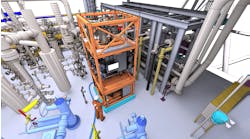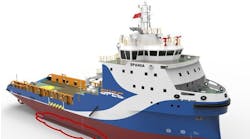Thiocyanate corrosion inhibitors suspected in chloride stress corrosion cracking
Tubing failure shares a common thread
Ed Robinson
Baroid/Halliburton
Recent analyses of catastrophic packer fluid-related failures suggest that discontinuing the use of thiocyanates in non-zinc brines can mitigate the problem. The relationship between stress corrosion cracking (SCC) and comp-letion fluids and brine-based packer fluids is under scrutiny because of tubing failures associated with non-zinc brines. Among thous- ands of Gulf of Mexico wells completed using halide-brine packer fluids, the documented cases of tubing failure due to chloride stress corrosion cracking (CSCC) share a common thread; these wells were all completed with non-zinc brines inhibited with a thiocyanate inhibitor. No failures in zinc brines inhibited with thio-cyanate have been documented, although hundreds of wells have been completed with thiocyanate-inhibited zinc brines. Using thiocyanate inhibitors in non-zinc brines can result in a concentration of H2S that, in the absence of zinc, is not scavenged and can, with chloride, attack metal.
Contributing factors
No guidelines have been developed to clarify the complex issue of CSCC and metal selection. Materials specialists should be consulted with regard to specific environments that metal components will be exposed to. However, the following characteristics are generally associated with the occurrence of SCC:
- Low pH
- High temperatures
- Transgranular action
- Higher alloys
- Higher HRC value
- Anodic process
- Cl-
- Tensile stress
- Oxidants (oxygen and sulphur).
Chloride stress corrosion cracking
Like stress corrosion cracking, the risk of CSCC increases at lower pH levels and higher temperatures. Based on an Erskine field tubing failure analysis, Texaco concluded that the three conditions listed below must be present in order for CSCC to occur:
- A chloride containing water phase
- An oxidizing agent (most commonly oxygen) or an acid
- Tensile stress, either applied or residual.
The probable process of CSCC is the migration of Fe++ through the passive layer leaving voids behind. The voids coalesce and can form cracks under stress. One means of determining that a failed metal has experienced CSCC rather than hydrogen embrittlement (HE) is the existence of branched transgranular cracks that go through rather than around the grains. Because CSCC is an anodic process, it is the converse of HE. The existence of one precludes the possibility of the other. The failures were diagnosed as CSCC.
null
There are other combinations of chemicals that can cause failure of alloys susceptible to SCC. Any electrolyte containing a chemical capable of partially destroying the corrosion resistant alloys (CRAs), normally protective passive film under anodic electrochemical conditions, may be responsible for SCC. The initiation of SCC may not require O2 or other oxidants. The H2S/Cl- synergism causes pitting and may result in cracking of CRAs.
Thiocyanate corrosion inhibitors
Thiocyanate inhibitors for oilfield corrosion inhibition include sodium thiocyanate, ammonium thiocyanate, and potassium thiocyanate. No evaluation has been conducted to determine a difference in performance by the various thiocyanates. While the use of thiocyanate inhibitors in non-zinc brines is a common feature in the CSCC failures documented to date, it has not been established whether all thiocyanates or only one of the above forms promote failures. Ammonium has the potential to thermally degrade into ammonia and free H+, certainly increasing CSCC and HE risk by lowering the pH.
The thiocyanate inhibitors, developed specifically for ZnBr2 brines, function by forming a zinc/iron sulfate complex that plates the metals (similar to galvanizing). They were primarily designed to protect carbon steel and low alloy steel (LAS). In the absence of zinc (or with zinc in an extremely low pH environment), the thiocyanate inhibitor can thermally degrade with H2S as a byproduct. In the presence of zinc, an effective H2S scavenger, the presence of H2S is mitigated.
The GoM completion fluids industry has consistently used thiocyanate inhibitors for zinc brines. No acceptable alternatives are available at present. For deeper, hotter wells, thiocyanate use was expanded to non-zinc brines in wells that exceeded the temperature limitations of amine-based inhibitors. As noted above, the addition of thiocyanate inhibitors in non-zinc brines can result in a concentration of H2S, which, if not scavenged by zinc, can aggressively attack CRAs. Due to the potential evolution of H2S gas in non-zinc brines at temperatures of 300°-340° F, some suppliers add a percentage of zinc in these applications. The absolute percentage of zinc required for effective scavenging has not been established.
An extensive review conducted in 2001 shows that SCC in CRAs could be traced in part to the misapplication of thiocyanate inhibitors. Test results with martinsitic stainless steel (MSS) and duplex stainless steel (DSS) demonstrated that the presence of thiocyanate "low allow steel corrosion inhibitors" (SCN-) resulted in SCC. No SCC occurred in the SCN-free brines. The synergism between H2S and calcium chloride (CaCl2) was further demonstrated in the Malaysian Resak A-6 well investigation. All U-bend specimens exposed to CaCl2 and simulated well fluid (H2S, CO2) suffered CSCC, while similar specimens did not in calcium bromide (CaBr2) pure and sodium bromide (NaBr) pure.
Failure analyses
Kawasaki Steel Corp. conducted a failure analysis on HP1-13Cr-110 tubing used on a High Island (Texas) location. The well was worked with high density ZnBr2 brine that may have carried risks of HE. The packer fluid was a CaBr2/CaCl2 blend inhibited with a thiocyanate and may have carried risk of CSCC. The tubing failed within one to two weeks. No definitive position was taken as to the specific cause of the failure, but demonstrated corrosion tests that while thiocya-nates in non-zinc brines can limit corrosion rates in terms of total metal loss, the non-zinc brines can experience pitting corrosion that can lead to further complications.
The investigation of a Shell Deep Alex 22Cr DSS failure in an 11 ppg CaCl2 inhibited with a thiocyanate inhibitor determined that the cracking propagated and spread from the outside of the tubing. Tests on 11 ppg CaCl2 (de-aerated) with no additives did not exhibit SCC, while the CaCl2 with the ammonium bisulphate O2 scavenger and thiocyanate inhibitor did exhibit SCC. The first inhibited test uncovered an unexpected H2S smell. Subsequent tests measured up to 5 psi H2S that was not initially present. Clearly, the failure mechanism was caused by H2S generated by the thermal degradation of the thiocyanate inhibitor. However, the beneficial effects of the presence of LAS were also established during this investigation. Even partial removal (oxygen) by corroding carbon steel in the test solution was sufficient to prevent cracking in these laboratory tests.
null
The Shell Deep Alex failure investigation cautions against the use of thiocyanates without making a distinction between zinc brines and non-zinc chloride containing brines. However, it appears thiocyanates are successfully used in zinc brines. The vast majority of wells completed with zinc bromide packer fluids have been inhibited with thiocyanate inhibitors.
No acceptable substitute is available for thiocyanate inhibitors in ZnBr2 because amine-based inhibitors permit unacceptable corrosion rates (for LAS casing). No case of tubing failure has been documented in any of these wells, which does not preclude misdiagnosed complications.
SCC testing
Recently, SCC testing was conducted in conjunction with an operator, specific to well conditions for an upcoming job. The parameters were a bottom-hole temperature of 340° F and a required packer fluid density of 13.2 ppg.
Nine individual combinations were tested for seven-day and 28-day corrosion rates. They were weighed for metal loss and sent for scanning electron microscope analysis for pitting corrosion in addition to the SCC tests. The "Hyper Chrome" 13Cr-110 failed in the 13.2 ppg CaCl2/CaBr2 inhibited with thiocyanate. It did not fail and did not experience progressive pitting in either the 13.2 ppg CaBr2 pure or the 13.2 ppg potassium formate.





